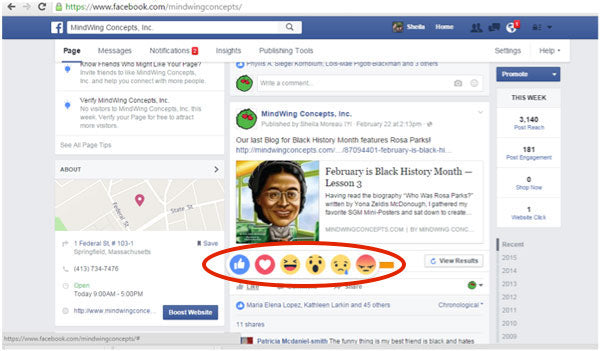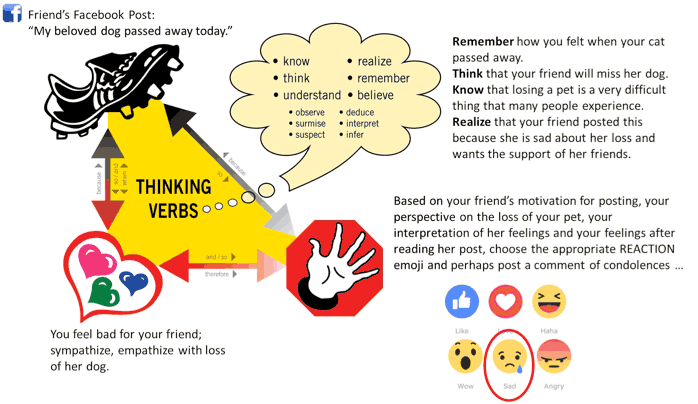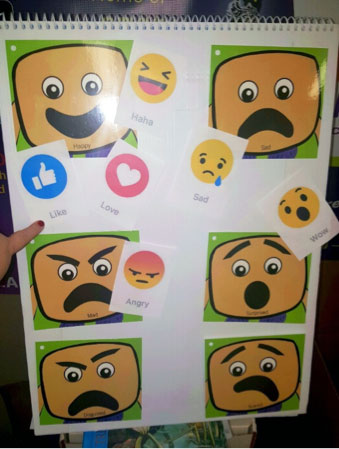Menu
-
- Home
-
About Us
-
The Approach
-
Linking Language & Literacy
-
MindWing Learning
-
Learning Resources
-
SHOP
-
Blog
-
- About MindWing
- Our People
- Contact Us
- Your Account
- Login
-
Spain (EUR €)

“REACTIONS” on Facebook – New Emojis!
February 25, 2016 2 min read
Have you seen them? Have you used them yet? Do you like them? On Wednesday, Facebook launched new “REACTION” emojis in place of the “like” button. Below is an example of the new reaction emojis on our MindWing Concepts, Inc. FaceBook page.

“We heard from people that they wanted more ways to express themselves on Facebook,” said Facebook product manager Sammi Krug. “When people come to Facebook, they share all kinds of different things, things that make them sad, things that make them happy, thought-provoking, angry. We kept hearing from people that they didn’t have a way to express empathy” (Chaykowski, 2016). This article went on to say that the ability to express empathy was very important to FaceBook CEO Mark Zuckerberg.
For many students, expressing and identifying emotions is a challenge in “real life” social situations. We use Story Grammar Marker® and Braidy the StoryBraid® to focus on developing these skills. Identifying emotions in ourselves and in others involves perspective-taking and theory of mind, two areas of focus in our Autism Collection for Social Communication. Empathy building is a hot button for all of our students, whether they have learning or social learning challenges or not. Helping them to navigate feelings, perspectives and motivations necessary for empathizing with someone is difficult in personal and social situations in real life, let alone online.
The challenges of knowing how to interpret intentions, motivations, emotions and tone of voice in the written word have evolved over the past 20 years; first it was with email, then it was with texting, now it is with any number of social media outlets. Many adults are not even very good at it, let alone children or adolescents who may or may not have language disabilities, learning problems or social communication challenges. It is becoming more important than ever for us to work on skills revolving around emotions and motivations. There are thousands of reasons and examples about why this is so important in the information age – in personal situations, school and the workplace.
Below is an example of how to empathize with a friend’s post on Facebook by using the Critical Thinking Triangle® to evaluate your/your friend’s perspectives, your friend’s motivation, your/your friend’s feelings. This will help your students to appropriately “comment” and choose a Facebook reaction emoji to empathize with their friend.

For younger students, a key component of social emotional development is identifying emotions in one’s self and in others. Braidy® can be used to develop these skills. Below is the Braidy the StoryBraid® Doll looking “surprised” as well as the Braidy® Manual, which includes many lessons that focus on the Six Universal Feelings.

The next photo shows the Six Universal Feelings as depicted in the Our Friend Braidy® Interactive Poster, along with corresponding Facebook Reaction Emojis of “Like,” “Love,” “Haha,” “Sad,” “Wow,” and “Angry.”
 Braidy the StoryBraid® can be used to help young children to learn about feelings and emotions which will lay the groundwork for motivations and perspective taking as they get older and as their communications become more multimodal and complex.
Braidy the StoryBraid® can be used to help young children to learn about feelings and emotions which will lay the groundwork for motivations and perspective taking as they get older and as their communications become more multimodal and complex.
Chaykowski, K. (2016). Facebook no longer just has a 'like' button, thanks to global launch of emoji 'reactions'. Forbes. Retrieved From: http://www.forbes.com/sites/
kathleenchaykowski/2016/02/24/
facebook-no-longer-just-has-a-like-button-thanks-to-global-launch-of-emoji-reactions/#6fe5451f4994
Leave a comment.
Comments will be approved before showing up.
